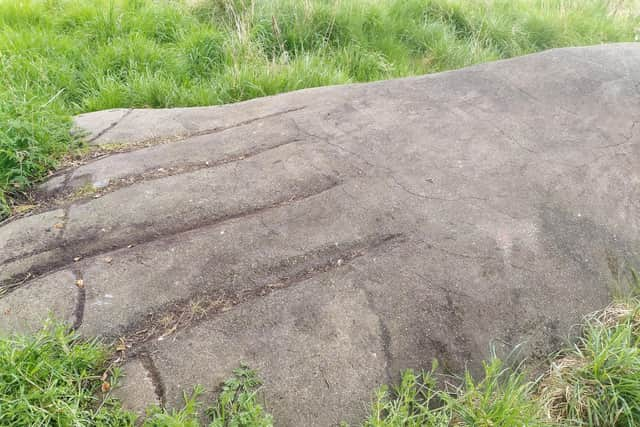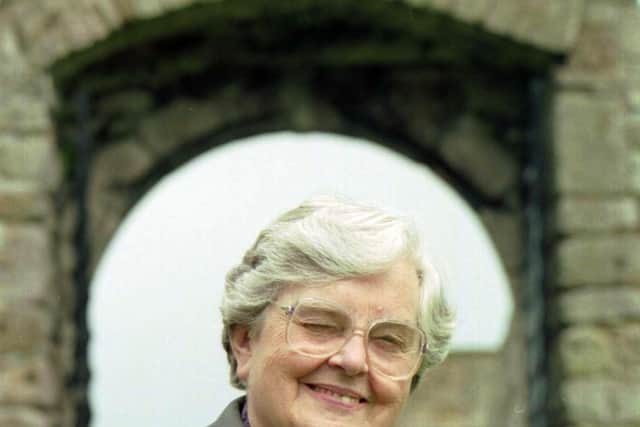The story behind Gulliver's concrete foot in a Scottish park now listed by heritage chiefs
He was a giant, radical statement of the time that brought worldwide attention to an Edinburgh neighbourhood and its residents.
Gulliver – also known as the Gentle Giant – once sprawled over the west side of Hunter’s Hall park in Craigmillar. His concrete form, some 33m in length, became a focal point of the community whose people rose up in the 1970s to use music, art and culture as a force for good, a force of change and a force for self belief.
Advertisement
Hide AdAdvertisement
Hide AdControversially at the time, Gulliver, who had a network of tunnels and hideaways built into his body, making it a place for kids to play, was designed by convicted murderer and former Glasgow gangster Jimmy Boyle. This design took place while Boyle was a prisoner at Barlinnie and an attendee of the prison’s Special Unit where art was used as a tool for reform.


The statue drew global interest, with artists from Australia and Chicago helping to create this new giant of the grassroots community arts movement – the largest concrete sculpture in Europe at the time. Sociologists, planners and academics also made the journey to the south east of the city.
There, they found a group of mothers, including Helen Crummy, leading the Craigmillar Festival Society, which was set up after her request to her son’s school for music lessons was dismissed as something that wouldn’t happen around here. She was later awarded with a MBE for her campaigning work, with a memorial to the late campaigner showing her passing a violin bow through an open door to her boy.
Amid the hype of the Craigmillar movement, Billy Connolly officially ‘opened' Gulliver in 1978.
Today only Gulliver’s left foot survives down by the Niddrie Burn, with the remainder of the giant dismantled in 2011 to make way for alterations to the waterway. Now Historic Environment Scotland (HES) has listed the foot, which still manages a powerful statement of the grassroots movement that mobilised this place.


HES has made the foot a listed C structure following a request from a member of the public to protect what is left of Gulliver.
A statement from HES said Gulliver's foot met the criteria for special architectural or historic interest given it was a “celebrated example of participatory, community-led public sculpture in Scotland”.
HES said it was a “rare tangible marker” of the work of the Craigmillar Festival Society, which the historic body described as “one of the most important and influential community-led regeneration initiatives of its time”, during the 1970s.
Advertisement
Hide AdAdvertisement
Hide AdA statement added: “The Gulliver Sculpture was an early and influential example of community-generated, participatory public art in Scotland. The surviving remnants are representative of stylistic themes and social trends within the community art movement, public art and 'outsider' art during the post-war period.
“The remnants are evidence in the landscape of the work of the ground-breaking Craigmillar Festival Society (1962-2002), its community-led approach to social regeneration through artistic endeavour, and the emergence of grass-roots initiatives across Scotland and further afield during that period."
The sculpture was constructed between 1976 and 1978 by the society's art team headed by Rosie Gibson and a group of local volunteers as part of a local job creation initiative. Community artists, including Ken Wolverton from Australia and Beth Shadur from Chicago, were also involved.
Using a grassroots approach that became known as the 'Craigmillar Formula', professional artists were employed on terms laid down by the society to work alongside local people.
With their aims championed by local politicians and receiving substantial funding from the European Economic Community, the society achieved a level of political influence later described as cultural democracy in action, HES said.
More than 200 local people were employed by the society on a full or part-time basis by 1976, with groups such as the Easterhouse Festival Society and the Cranhill Arts Project going on to be influenced by what was happening in Craigmillar, HES said.
Amongst those visiting Craigmillar were eminent behavioural sociologist and founder of the Tavistock Institute, Eric Trist, who claimed the community was at the leading edge of post-industrial innovation. German artist Joseph Beuys, who helped develop the concept of "social sculpture" and who worked with Edinburgh-based artist Richard Demarco in promoting the work of the Barlinnie Prison Special Unit, where Boyle developed his artistic talents, was also a fan.
The choice of Boyle, who now lives in France, to design the statue met with some disquiet at the time.
Advertisement
Hide AdAdvertisement
Hide AdA statement added: “Controversially, the Festival Society commissioned Jimmy Boyle to design the Gulliver Sculpture while he was serving a sentence for murder at Barlinnie Prison in Glasgow.
"His widely publicised social rehabilitation as an artist, sculptor and author as part of the Barlinnie Special Unit arts programme during the 1970s shared affinities with the Craigmillar Festival Society's use of art as a catalyst for social change.
"In 2004, Boyle noted that he intended the sculpture to be 'a symbol of that particular period when disadvantaged communities were for the first time demanding to be heard'.”
Gulliver remained a popular place for children to play throughout the 1980s, although increasingly became associated with anti-social behaviour after a boundary fence was placed between the sculpture and the reconfigured housing development in a move that pushed the statue away from the people.
Now, with Gulliver’s foot protected for the future, people may well be led to him once again.
Comments
Want to join the conversation? Please or to comment on this article.